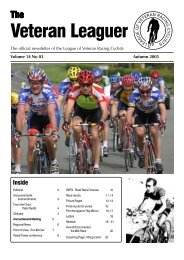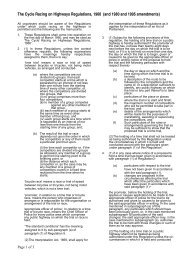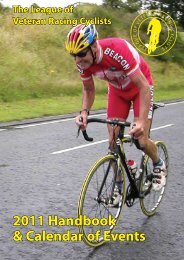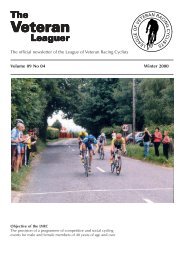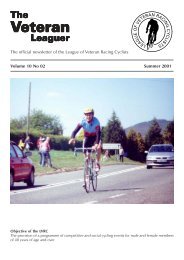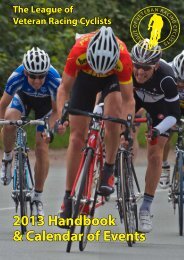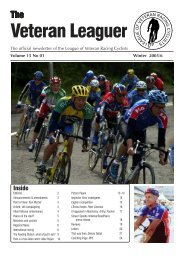You also want an ePaper? Increase the reach of your titles
YUMPU automatically turns print PDFs into web optimized ePapers that Google loves.
Coach: in the Interval<br />
Anyone knows that if you ride<br />
around at 15 mph you’ll get very<br />
good at riding at 15 mph. But you<br />
can’t then expect to feel OK racing at 25<br />
mph plus. You therefore have to overload<br />
your body’s systems to provoke overcompensation<br />
during the resting/recovery period.<br />
Intensive training is very demanding,<br />
draining and exhausting. Training for a 40-<br />
mile race by repeatedly riding 40 miles in<br />
1.40 is not the answer. However, it was<br />
shown many years ago that repetitions of<br />
short bursts of high intensity work with<br />
short rests between each were more effective<br />
than a single long stretch of high<br />
intensity work. This kind of training is<br />
called interval training. Interval training<br />
should not be confused with sprint training.<br />
Sprint training aims to develop greater<br />
speed: interval training stresses the body<br />
to force it to adapt to greater physical efforts.<br />
Interval training develops the cardiovascular<br />
system, develops strength through<br />
progressive overload of the muscles, develops<br />
endurance and speed, and improves<br />
tolerance to pain. It also reduces blood<br />
lactate levels at given work-loads, and<br />
brings about changes in slow-twitch muscle<br />
fibres (the ones that you depend on for<br />
endurance) with consequent improvements<br />
in speed.<br />
Interval training has always been based on<br />
the principle that the high intensity interval<br />
and the rest interval are of such a length<br />
that the body does not have time to recover<br />
fully before the next high intensity<br />
interval begins. However, recent research<br />
and training techniques by Dr Gordon<br />
Wright, working with Stuart Dangerfield,<br />
suggest that long er rest periods between<br />
efforts may be beneficial: for instance,<br />
flat-out efforts of four minutes are followed<br />
by 12-minute recovery periods.<br />
For cyclists intervals can be of many kinds.<br />
Here are some. Note that before doing<br />
interval training you should already have<br />
reached a good level of fitness with a<br />
large base of endurance training. Trying<br />
to do high intensity speed work from the<br />
start is like trying to build a house on no<br />
foundations. Always warm up thoroughly<br />
(30 minutes) before beginning the interval<br />
work, and warm down afterwards. You can<br />
do intervals anywhere, preferably on quiet,<br />
traffic-free roads, or on the turbo. The advantage<br />
of the turbo is that you have no<br />
distractions or dangers and are in complete<br />
control.<br />
Short sprint intervals<br />
Sprints of 6 seconds on a racing gear (53 x<br />
15 or bigger), absolutely flat out as hard as<br />
you can go, followed by a rest period (spinning<br />
on a small gear) of around 1 minute.<br />
Around a dozen is the maximum you<br />
should aim at. Time starts when you jump,<br />
so you’re better off counting seconds than<br />
trying to look at a watch. If outdoors try to<br />
pick a stretch with the wind. You should<br />
not feel very tired afterwards.<br />
Long sprint intervals<br />
As for short sprint intervals, but the sprints<br />
will be 12 – 15 seconds in duration. Leave<br />
a longer rest period (2 – 3 mins) between<br />
the sprints and do fewer, perhaps 6 – 10<br />
depending on how you feel.<br />
Power intervals<br />
Done up an incline (but not a steep hill),<br />
in a high gear (typically 53 x 12 – 14), for<br />
up to a minute at maximum effort, with two<br />
to three times the amount of recovery. Aim:<br />
to build power.<br />
Low intensity<br />
Sometimes called ‘time-trial’ intervals. 5<br />
mins at 80 – 85% of peak sustained power<br />
with rests of only 1 minute. They should<br />
not feel exhausting, and a fit rider should<br />
be able to do six or eight. You can vary the<br />
system with 6 x 5 min, 8 x 4 min, 10 x 3<br />
min. Good for building power.<br />
High Intensity<br />
Usually short (1 – 2 min), five to ten repetitions,<br />
always at 100% effort, with 1<br />
minute rest periods. Exhausting.<br />
Russian steps<br />
Easy to do on the turbo. Start with 1 minute<br />
on, 9 minutes off; then 2 on, 8 off; 3 on, 7<br />
off; 4 on 6 off; 5 on, 5 off. If you’re still<br />
fresh enough, do five more in reverse, finishing<br />
with 1 minute on. Intensity: 100%.<br />
Hill intervals<br />
These are done on hills, preferably with<br />
steady gradients. They may range in intensity<br />
from 80 – 100% and last from 1 minute<br />
to 5 minutes.<br />
Points to watch<br />
v Don’t be tempted into actually stopping<br />
during the rest period, especially<br />
if you’re on the turbo. Continuing<br />
gentle exercise speeds recovery because<br />
it promotes blood flow through<br />
the muscles, removing lactic acid.<br />
v<br />
Don’t do interval sessions more than<br />
twice a week. You might do a low intensity<br />
session for one, and short intervals<br />
for another.<br />
Stuart Dangerfield’s pyramid of<br />
interval training ends with four<br />
2½-mile efforts in around 4.30<br />
each (33 mph) with 12-minute<br />
recovery intervals.<br />
Short intervals<br />
Typically 1 – 1½ minutes in duration with<br />
rests of about double the interval in between,<br />
i.e. 1 minute on, 2 minutes off.<br />
Generally you’ll do these at 90% - 100%<br />
of max heart rate, but always above your<br />
threshold. They cannot therefore be longer<br />
than 2 minutes. The principle is to do your<br />
first interval at a set effort and time it. Subsequent<br />
intervals should be at the same<br />
effort and completed in the same time. As<br />
soon as your time exceeds 10% of your initial<br />
effort, then stop: further training will<br />
not be effective. You will feel tired, probably<br />
very tired.<br />
v<br />
v<br />
v<br />
Only do intervals when you’re fresh,<br />
rested, and feel like doing them. Stick<br />
precisely to the scheduled intervals.<br />
Always allow at least two days after<br />
interval training before your next<br />
race.<br />
For whatever intensity, choose a gear<br />
that allows you to pedal at 90 – 120<br />
rpm. The only training that should be<br />
done at very low revs (50 rpm) is pure<br />
strength training on very high gears.<br />
V<br />
Page 24 <strong>Veteran</strong> Leaguer: Winter 2002



